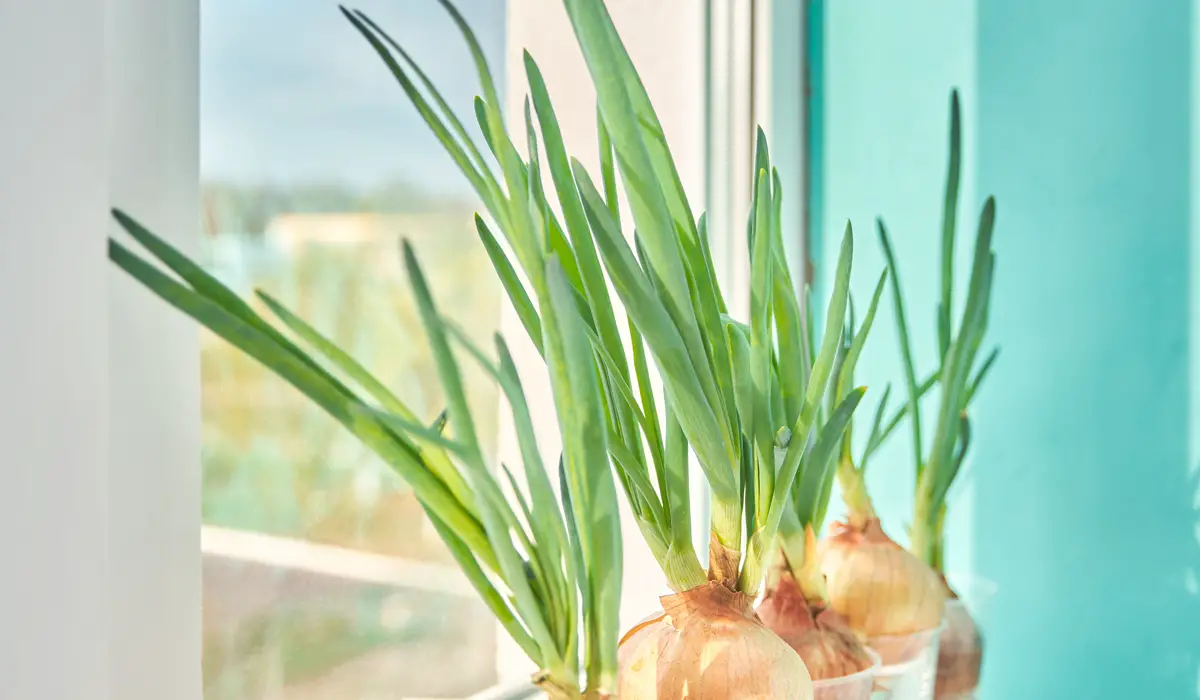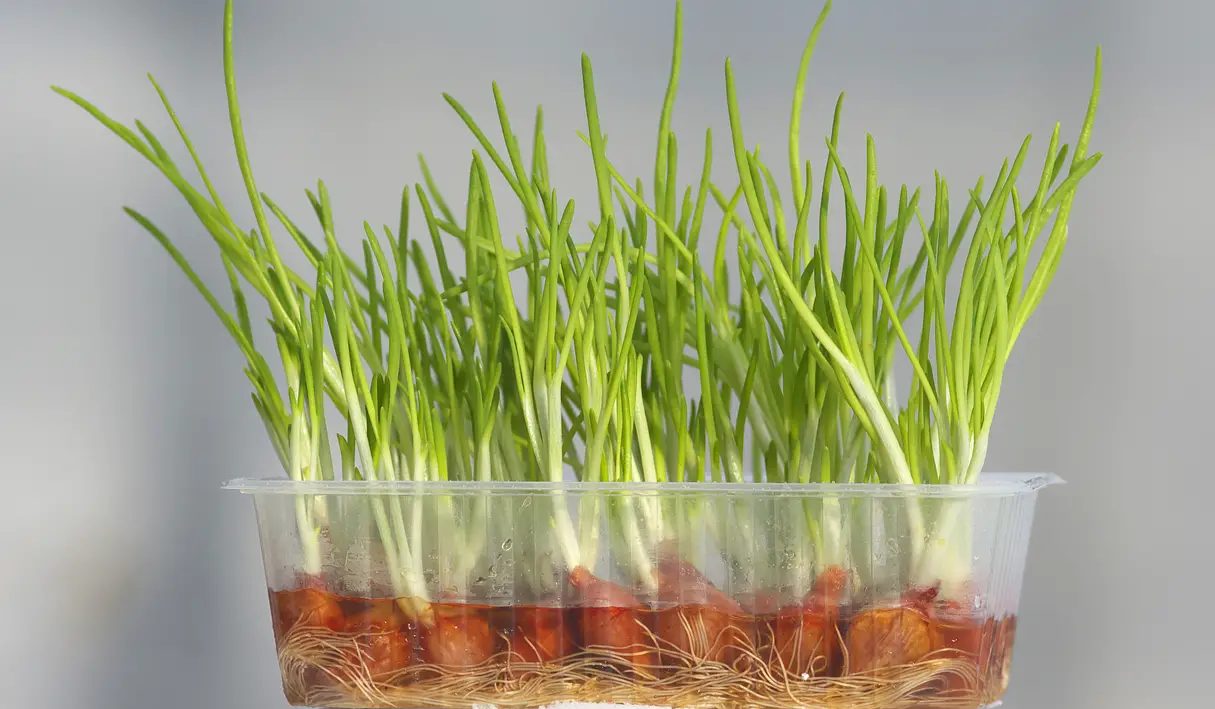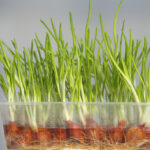Hydroponic Onions: A Complete Guide To Growing the Best Onions Indoors

This post follows our research editorial guidelines.

Onions are a kitchen staple that prove surprisingly easy to grow in hydroponics. I love using the fresh greens spring onion style for a crisp and gentle onion flavor and the onions themselves can be harvested at the end of the season and stored for later use. They are after all a bulb and no harder to grow in hydro than a tomato or a paperwhite jonquil.

Table of Contents
Can You Grow Hydroponic Onions?
Hydroponic onions grow well from seed or a starter bulb called a ‘set’. Controlled light will allow for best bulb formation. Choose a system suited to your preferred end product – green onion sprouts or bulbs.
Onions are cheap to purchase at the grocery store but there really is something satisfying to growing them yourself. There’s also a lot to be said for growing shallots or scallions at home. They start to lose flavor the second they’re harvested so I like to cheat and grow them close to my kitchen. It’s hard to lose much flavor when you only have to transport them a few feet!
How Long Does It Take To Grow Onions Hydroponically?
Fresh onion greens will be ready to harvest in as little as a month. When grown from starter bulbs called ‘sets’ you’ll be able to take your first clippings as soon as they’re five or six inches long. The age of the set, the quality of your light and your nutrient solution will all have a part to play.
If you’re growing for bulbs you’ll be in for a wait. Onion bulbs can take as little as three months and as long as six depending on the cultivar.
Best Onion Varieties For Hydroponics

Green onions
The Tokyo Long White cultivar is a classic green onion that concentrates its growth in leaves rather than the bulb. It’s also more disease resistant than most and can shrug off root issues that would otherwise doom an entire hydroponic crop.
White onion
For general purpose onions, the Patterson cultivar is a great all-rounder and one of the easier varieties to grow. It’s a long day onion that produces medium sized bulbs after about three months or so.
Red onions
The Italian Torpedo onion is a compact red onion with a classic full flavor. They’re smaller than most reds so you can get more of them into an indoor rig without sacrificing on flavor.
Sweet onions
Sweet Spanish White is a great sweet onion for hydro. It produces a compact almost perfectly round bulb that will take up little space while still producing excellent returns for your labor.
If you want a larger option, White Grano produces hefty bulbs about twice as large. It’s a short-day variety, and requires less light than most to thrive.
What Hydroponic System is Best for Onions?
Onions aren’t fussy. They’ll do just fine in most types of hydroponic systems. That being said, Deep Water Culture systems work best for onions because it allows total control over the nutrients without too much outlay of space or time. You can tinker with the formula to your hearts content and it’s easy to find room in my space for a small container here and there.
Nutrient Film Technique systems are also excellent for growing onions, especially if you’re more interested in bulbs than green sprouts. Vertical systems are especially good for onions as they maximize the airflow around the leaves and help prevent disease.
How to Grow Hydroponic Onions from Seeds

Onion seeds are cheap and easy to obtain. Even if you’re in the middle of nowhere it’s easy to have them posted. The downside is they often don’t sprout at all, so plant more than you need to ensure success.
You will need:
- Onion seeds
- Seed raising medium
- Propagation tray with clear lid
- Clean water
- Sheet of paper or card
Step One
Fill your propagation tray with a two inch deep layer of soil-free seed raising medium. You can also use rock wool or oasis cubes if that’s compatible with the hydroponics system you’ve opted to use.
Soak rockwool or oasis, or water trays of medium well. Pure distilled water is best -save the nutrient solution for later.
Step Two
Sprinkle the seeds evenly across the surface of the medium and cover with about a third of an inch of soil. If using rockwool, insert three or four seeds one third of an inch deep.
Step Three
Place the sheet of paper or card over the surface and close the lid. Onions like darkness to sprout.
Rockwool or oasis can be placed in the tray with a half inch or so of clean water at the bottom to ensure the cubes remain moist.
Step Four
Place the tray in a warm location away from direct light. It will take about ten days for them to sprout.
I would suggest you allow them to develop their first true leaves before you transplant. In the meantime, water with pure water only to prevent nitrogen burn on the fragile newborn roots.
Step Five
Transplant only the strongest seedlings to your hydroponics setups. Seedlings can be relocated from seed raising mix into baskets or trays of loose medium.
Cubes of rockwool or oasis are even easier. Thin the sprouts so there is only one strong seedling per cube, and pop the lot into position.
How to Grow Hydroponic Onions from Sets

Onions are best grown from immature bulbs called ‘sets’. They’re already proven to be viable and cut the guesswork from germinating seeds. They have roots and are ready to go, after all.
Step One
Remove your sets from their packaging and wash the roots to remove any loose dirt. Any papery dry outer layers can also be removed.
Step Two
Sort your sets into two sizes. Small ones are better for growing bulbs, and larger ones will yield better onion greens.
Step Three
Place your desired sets in baskets of medium or in the growing trays. A fine grained medium with good flow through is best, like a 1-1 mix of perlite and vermiculite.
Insert only the root tips and as little of the base of the set as is needed to maintain stability. Like any bulb the sets are liable to rot if they are allowed to become waterlogged.
Step Four
Sets can be considered a light feeder as they become established. Use a half or even quarter strength solution for the first week or so before gradually increasing the concentration.
Light
“An important aspect of onion development is photoperiod or day length…Bulb formation begins when a certain day length is reached. Short-day onion varieties begin to form bulbs when they receive 11 or 12 hours of daylight, intermediate-day onions need 12 to 14 hours of daylight, and long-day varieties require 14 or more hours of daylight.” Richard Jauron, Horticulturist at Iowa State University Extension
Onions typically have three different types of light requirement – short day, day neutral or intermediate, and long day. You’ll need to make sure your photo interval matches the onion you’re growing.
Poor light will result in smaller onions and shorter shoots. If you’re worried about the power consumption of your crops then it’s best to stick to short day onion varieties.
Water
Keep your solution between pH 6.0 and 6.8. They don’t appreciate anything but the most neutral of conditions.
It’s a good idea to keep the roots cool, too. Don’t let them creep too much further above 68°F. It’ll prevent fungal problems in the roots.
Nutrients
Before you choose your nutrient solution you need to decide if you want to eat the fresh green shoots or harvest the bulb once mature. High nitrogen solutions designed for foliage will result in a fantastic harvest of leaves – but at a cost. Too much nitrogen will result in flavorless bulbs as the plant pushes all its resources into the leaves.
You’ll need to ensure lower amounts of nitrogen if you want a delicious bulb.
As far as the EC goes, start slow and build. 2.0 is ideal for the establishment period, and once roots are going well the solution can be enriched to about 2.6
Spacing
Onions grown for their leaves can be grown closer together than those grown for their bulbs.
For green onion, aim for a spacing of around 18 plants per square foot. For onions grown to harvest the bulb, half is better – 9 per square foot.
Pests
Onions are somewhat more pest resistant than most, and a lot of their enemies struggle to get into indoor growing operations.
Thrips are really your biggest pain to deal with for indoor onions. They’re tiny little nightmares that resemble iron filings and they burrow into the leaves to nibble away at the delicious tissue inside.
Disease
Onion leaves are an attractive host for a few conditions, most commonly downy mildew and Botrytis. Both love stale air so you can generally dodge them with good ventilation.
Onions are vulnerable to a few root conditions. Pink root disease seems cute but it turns the fine root hairs pink before attacking the bulb. Fusarium is a soil born pathogen that sets up camp at the neck of the bulb, destroying tissue and preventing growth. Most of these are soil born and can be prevented with good hygiene.
I’d also be in remiss if I forgot to bring up the twin enemies of all hydro, Pythium and Phytophthora. These two are water molds that love the stable, warm conditions of hydroponics setups and are difficult to treat once they get established. Keep nutrients cool to prevent infection.
| Hydroponic Onion Growing Quick Guide | |
| Light | Min. 11 hours, up to 16 for long day varieties |
| Water | PH 6.0-6.8 |
| Growing Medium | Inorganic |
| Nutrients | EC 2.0 – 2.6 |
| Spacing | 18 per square foot for green onion, 9 for bulbs |
| Temperature | 70-68°F (18-20°C) |
| Pests | Thrips |
| Disease | Mildew, Botrytis, Pink Root Disease, Fusarium, Pythium, Phytopthora |
Kratky Onions Growing Method
Onions will grow just fine in a simple Kratky rig, especially if you’re more interested in the greens than the onion itself. A polystyrene container with a few holes poked through the lid for the sets is all you really need for some serious passive production and can produce results that surpass expectations.
Is it better to grow onions in water or soil?

If you live in a well lit, warm region with lots of light and space to spare you may well do better to put your onions in the ground. But for most of us home growers a hydroponic setup will work wonders to get a good steady supply of onion greens and bulbs all year round. They’ll do well in just about any type of hydroponic system and are even good candidates for vertical systems, too.
Final Thoughts
Fresh is best when it comes to vegetables and it’s hard to go past the pungent perfection of hydroponically grown onion greens direct from the plant to my plate. That fantastic fact has me checking the kitchen staples and seeing if I can grow them myself. Tomatoes, peppers and even hydroponic carrots are now fast favorites for my family’s table.
